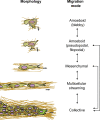Plasticity of cell migration: a multiscale tuning model
- PMID: 19951899
- PMCID: PMC2812848
- DOI: 10.1083/jcb.200909003
Plasticity of cell migration: a multiscale tuning model
Abstract
Cell migration underlies tissue formation, maintenance, and regeneration as well as pathological conditions such as cancer invasion. Structural and molecular determinants of both tissue environment and cell behavior define whether cells migrate individually (through amoeboid or mesenchymal modes) or collectively. Using a multiparameter tuning model, we describe how dimension, density, stiffness, and orientation of the extracellular matrix together with cell determinants-including cell-cell and cell-matrix adhesion, cytoskeletal polarity and stiffness, and pericellular proteolysis-interdependently control migration mode and efficiency. Motile cells integrate variable inputs to adjust interactions among themselves and with the matrix to dictate the migration mode. The tuning model provides a matrix of parameters that control cell movement as an adaptive and interconvertible process with relevance to different physiological and pathological contexts.
Figures


References
-
- Alt-Holland A., Shamis Y., Riley K.N., DesRochers T.M., Fusenig N.E., Herman I.M., Garlick J.A. 2008. E-cadherin suppression directs cytoskeletal rearrangement and intraepithelial tumor cell migration in 3D human skin equivalents. J. Invest. Dermatol. 128:2498–2507 10.1038/jid.2008.102 - DOI - PMC - PubMed
-
- Belletti B., Nicoloso M.S., Schiappacassi M., Berton S., Lovat F., Wolf K., Canzonieri V., D'Andrea S., Zucchetto A., Friedl P., et al. 2008. Stathmin activity influences sarcoma cell shape, motility, and metastatic potential. Mol. Biol. Cell. 19:2003–2013 10.1091/mbc.E07-09-0894 - DOI - PMC - PubMed
Publication types
MeSH terms
LinkOut - more resources
Full Text Sources
Other Literature Sources

